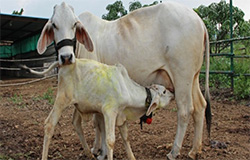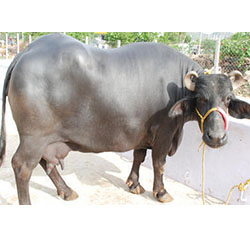
BACTERIAL DISEASES :-
1. ANTHRAX :-
Symptoms
1. In peracute sepeticemia death occurs within 2 hours after animal collapsing with convulsions,sudden death in animals that appeared normal is common.
2. Pregnant animals may abort and milk production often abruptly decreases.
3. Terminal signs include severe depression, respiratory distress and convulsions.
Prevention and Control
1. Prevention of anthrax in animals is aided by active immunization.
2. The organism is susceptible to penicillin-G, tetracyclines, erythromycin and chloramphenicol.
2. HAEMORRHAGIC SEPTECEMIA :-
Symptoms
Fever, a sudden drop in milk yield, signs of abdominal pain, severe diarrhoea and dysentery, respiration becomes rapid and shortly before death the mucous membranes appear cyanotic.
Control and prevention
Pasteurella is amenable to Penicillin-G, streptomycin, chloramphenicol, chlortetracycline, sulpha and tripmethoprim, enrofloxacin and oxytetracycline,
Vaccination
3. BLACK QUARTER :-
Symptoms
The disease usually occurs in young cattle of 6 months to about 2-3 years of age. Crepitating swelling in the hind or fore quarter, lameness, muscles shows trembling with violent twitching. Death usually occurs within 24 hours.
Control and prevention
Hyper immune serum (HIS) is used to control explosive outbreaks. Penicillin along with HIS is used to treat the disease.
Oxytetracycline & Chlortetracycline can also be employed effectively in early stages.
4. BOVINE TUBERCULOSIS :-
General form
Affected animals become docile, Progressive emaciation, Capricious appetite, fluctuating body temperature and rough / sleek hair coat, animal does not put up weight.
Respiratory form
Silent or paroxysmal cough especially during early morning and chilled weather. Chronic cough with dyspnoea, squeaking crackles , enlargement of retropharyngeal lymphnode causes dysphagia and noisy breathing due to pharyngeal obstruction.
Reproductive form
Metritis and inflammation of placenta leads to infertility, abortion and failure in conception.
Control and prevention
Treatment and vaccination are inappropriate in control programmes for cattle. In many countries, tuberculin testing followed by isolation and slaughter of reactors has been implemented as the basis of national eradication schemes.
5. BRUCELLOSIS :-
Symptoms
The disease in cattle is almost always caused by B.abortus.
The incubation period is usually from 30 to 60 days.
After bacteraemia the infection localizes in the placentae, if the animal is not pregnant, the infection localizes in udder (interstitial mastitis).
In the bull, orchitis and epididymitis.
Abortion at 6 months and retained placentae are the cardinal signs.
Prevention and control
The attenuated live vaccine is used in female calves 4 to 12 months of age.
The adjuvant bacterins is used as booster vaccine.
VIRAL DISEASES:-
1. FOOT AND MOUTH DISEASE:-
Symptoms
The disease is characterised by the formation of vesicles (fluid-filled blisters) and erosions in the mouth, nose, teats and feet.
Prevention & Control :
Thorough disinfection of shed, utensils, clothes of attendants.
Vaccination – polyvalent – once – 4months or varies with type of vaccine
METBOLIC DISEASES :-
1. Milk fever :-
Milk fever is a metabolic disease in cows soon after calving. Due to fall in serum calcium level in cows after calving as a result of failure to mobilize calcium reserves and of the development of negative calcium balance in late pregnancy.
Symptoms
Disease flares up with in 72 hours of calving initially the cows show excitement, incoordination of movement muscular tremors in limbs and head, lying in recumbent position with her head directed towards flank.
Treatment & Control
Dramatic recovery by intravenous administration of 300-400 ml calcium borogluconate with Vitamin D3 injected intramuscularly. Continued mixing of ½ liter of supernatant lime water for cow may reduce the incidence.
Bloat : (TYMPANY):-
Acute form of tympany results in sudden death before rendering any aid to the affected animal. In acute cases, the distension of the rumen occurs quickly, the flank and the whole abdomen is enlarged.
Diagnosis
Based on characteristic symptoms of distension of abdomen and distress by the affected animal.
Control and Treatment
In per acute cases puncture the rumen with a sharp knife or with a trocar and canula to expel the gases. Administer orally oil of turpentine 60 ml well mixed with one litre of groundnut oil or gingelly oil or cocounut oil. After six to eight hours administer powdered ginger 30 grams, Asafoetida 30 gram, well mixed to jaggery. Fresh legumes should be wilted and then fed to stallfed animals. Feed dry roughages before turning the cattle to luxuriant pasture to avoid bloating.
MASTITIS :-
Etiology
Mastitis is caused majorly by Staphylococcus, Streptococcus and coliform bacteria and less importantly by other organism such as other bacteria, viruses, and fungus.
Clinical signs
Per acute form: Pyrexia, anorexia, respiratory distress, swollen, hot and painful udder. Cessation of milk production. Exudate are often blood stained.
Acute form: Swollen udder, changes in quality of milk. Milk become curd like, yellow, brown fluid with flakes and clots.
Treatment
Stripping out the milk from the infected quarters. Cleaning of infected quarters with normal saline and distilled water. Infusion of antibiotic therapies immediately after the infection. Continuous use antibiotics as per the antibiogram.
Control:
Hygenic measures are important.
Animals diagnosed positive should be milked at last.
Milkers should wash their hands before milking and should use well washed white overalls.
A separate clean cloth for each cow is used for washing the udder with a disinfectant.
PARASITIC DISEASES:-
Anaplasmosis
Anaplasmosis is a vector-borne, infectious blood disease in cattle caused by the rickesttsial parasites Anaplasma marginale and Anaplasma centrale.
It can also be transmitted via contaminated needles, dehorning equipment, castrating knives, tattoo instruments, biting flies and mosquitoes.
BOVINE BABESIOSIS (Red water disease, Tick fever)
Bovine babesiosis is a febrile, tick-borne disease of cattle and buffalo, caused by one or more protozoan parasites of the genus Babesia.
The acute form is generally characterized by rapid growth and multiplication of the parasite in blood with extensive erythrocytic lysis leading to anemia, icterus, hemoglobinuria, enlargement of the spleen, and frequently, death.
Theileriosis
Theileriosis is a disease of mammals-
T. parva and T. annulata in cattle
Marked pyrexia, lymph node enlargement, dyspnoea, epistaxis, emaciation, diarrhoea and other GI signs.
Ocular signs and masses may develop.
Pruritus and skin lesions/plaques are also seen.





